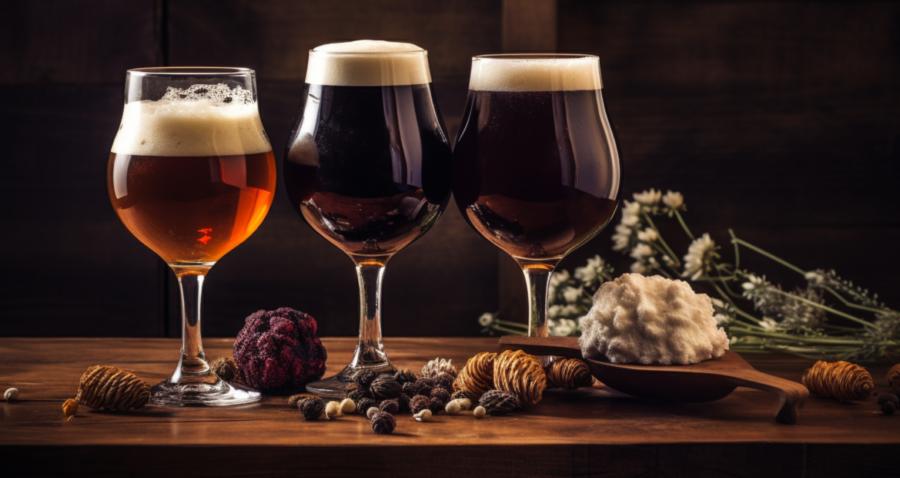Home Breweries: Crafting Beers and Wines

Embarking on the Fermented Adventure
Have you ever sipped a cold beer or savored a glass of wine and thought, "I could make this?" Well, you're in luck! Homebrewing is not just for bearded wizards hiding in a basement surrounded by bubbling cauldrons. In fact, it's an exciting and rewarding hobby for anyone with a passion for crafting their own boozy concoctions. With a little dedication, patience, and some good ol" fashioned trial and error, you can create your very own fermented beverages to share with friends, gift to family, or just enjoy by yourself on a lazy Saturday afternoon.Beers: Beyond the Six-Pack
Who says you have to settle for the same ol" boring beer from the store when you can create a truly unique brew? With seemingly endless combinations of grains, hops, and yeast, you can experiment with flavors and styles that put the mass-produced stuff to shame. And there's no need to feel overwhelmed by the brewing process; you can start small and gradually work your way up to more complex recipes.Equipment: Acquiring Your Mad Scientist Gear
Before you can begin brewing, you'll need to gather your potions kit. No, I don't mean eye of newt and toe of frog; I'm talking about brewing equipment such as:- A large boiling pot (at least 5 gallons)
- A fermentation vessel (a glass carboy or food-grade plastic bucket)
- An airlock (to let CO2 escape during fermentation)
- A hydrometer (to measure the sugar content of your brew)
- A thermometer (to monitor temperature)
- A spoon or paddle (for stirring)
- A siphon (to transfer your brew)
- Bottles or kegs (for storage)
Brewing Beer: The Ultimate DIY Project
Once you've assembled your equipment, it's time to get brewing. The basic process goes something like this:- Heat water and steep grains
- Add malt extract and bring to a boil
- Add hops at various stages of the boil for flavor and bitterness
- Cool the wort (unfermented beer)
- Pour wort into fermentation vessel and add yeast
- Wait patiently for fermentation to work its magic
- Transfer beer to bottles or kegs, then carbonate
- Enjoy your homemade masterpiece
Wines: Bringing the Vineyard Home
Perhaps you prefer to sip on a glass of vino rather than a frosty pint. Fear not, intrepid beverage enthusiast, home winemaking is just as attainable and satisfying as brewing beer. While the process may be slightly different, it follows a similar progression.Equipment: Winemaking Wizardry
While you may already have some of the necessary gear from your beer brewing adventures, winemaking does require a few additional items:- A primary fermenter (a large food-grade plastic bucket)
- A secondary fermenter (a glass carboy with airlock)
- A wine press (if using fresh fruit)
- A wine degasser (a long, drill-mounted stirring rod)
- Wine bottles, corks, and a corker
Winemaking: A Grape Escape
Once you've gathered your equipment, you can embark on your winemaking journey. You can start with a winemaking kit, which contains everything you need to make a batch, or venture into using fresh fruit for a truly bespoke creation.The basic winemaking process can be summarized as follows:
- Mix crushed fruit or wine concentrate with sugar and water in primary fermenter
- Add yeast and other necessary additives to kick off fermentation
- Allow to ferment for about a week, then transfer to secondary fermenter
- Allow wine to age and clarify for several weeks or months
- Rack wine, or siphon it off sediment, as needed
- Bottle, cork, and let your wine age to perfection
- Uncork and revel in your homemade vino victory
Conclusion: Embrace Your Inner Brewmaster and Vintner
Homebrewing and winemaking can seem intimidating, but with a little research, patience, and a hearty dose of experimentation, you can craft your own unique beverages that will impress your friends, family, and most importantly, your taste buds. So don your brewing apron, raise a glass, and cheers to the art of fermentation.Article kindly provided by yourhomengarden.org
Latest Articles
- Uncommon Ways to Estimate Waste Volume Before a Cleanup Project
- How to Spot and Tackle Hidden Moisture Problems Before They Become Renovation Nightmares
- How Underground Pipe Issues Can Lead to Structural Damage
- Simple Design Tricks That Encourage Backyard Biodiversity
- Why Your Showerhead Is Suffering From a Mineral Midlife Crisis
- Gateways That Turn Heads While Keeping Your Property Safe
- Listening Pipes: Using Sound to Diagnose Hidden Home Plumbing Issues
- Small Changes That Make a Kitchen Feel Completely New
- Scents That Refuse to Leave and How to Outwit Them
- How Personalisation Makes Homewares Feel Special
- Asphalt Advantage and the HOA Budget Balancing Act
- The Step-By-Step Process of Turning a Garden Vision into Reality
- Rain Doesn't Fall Straight: Why Roof Shape and Wind Matter More Than You Think
- How Fire Pit Design Quietly Shapes Human Connection
- Invisible Passengers Who Never Pay the Fare
- When the Ground Has Opinions: Learning to Hear Tree-Soil Conversations
- When Windows Sweat: What Condensation Reveals About Your Home's Hidden Climate
- Vertical Micro-Oasis for Kitchen Herbs in Tight Urban Spaces
- Why Clean Workspaces Quietly Boost Creativity
- Color-Coding Your Backyard: a Homeowner's Guide to Safe DIY Marking
- Interior Design
- Home Improvement
- Gardening
- Home Organization
- Home Maintenance
- DIY Crafts
- Kitchen and Dining
- Bathroom Design
- Home Security
- Home Automation
- Green Living
- Home Office
- Home Decor
- Garden Design
- Pet Care
- Home Technology
- Landscaping
- Home Energy Efficiency
- Home Cleaning
- Home Safety
- Home Exterior
- Home Insulation
- Home Buying
- Home Selling
- Renting
- Tradespeople
- Garage
- Bedroom
- Painting and Decorating
- Plumbing and Drainage

